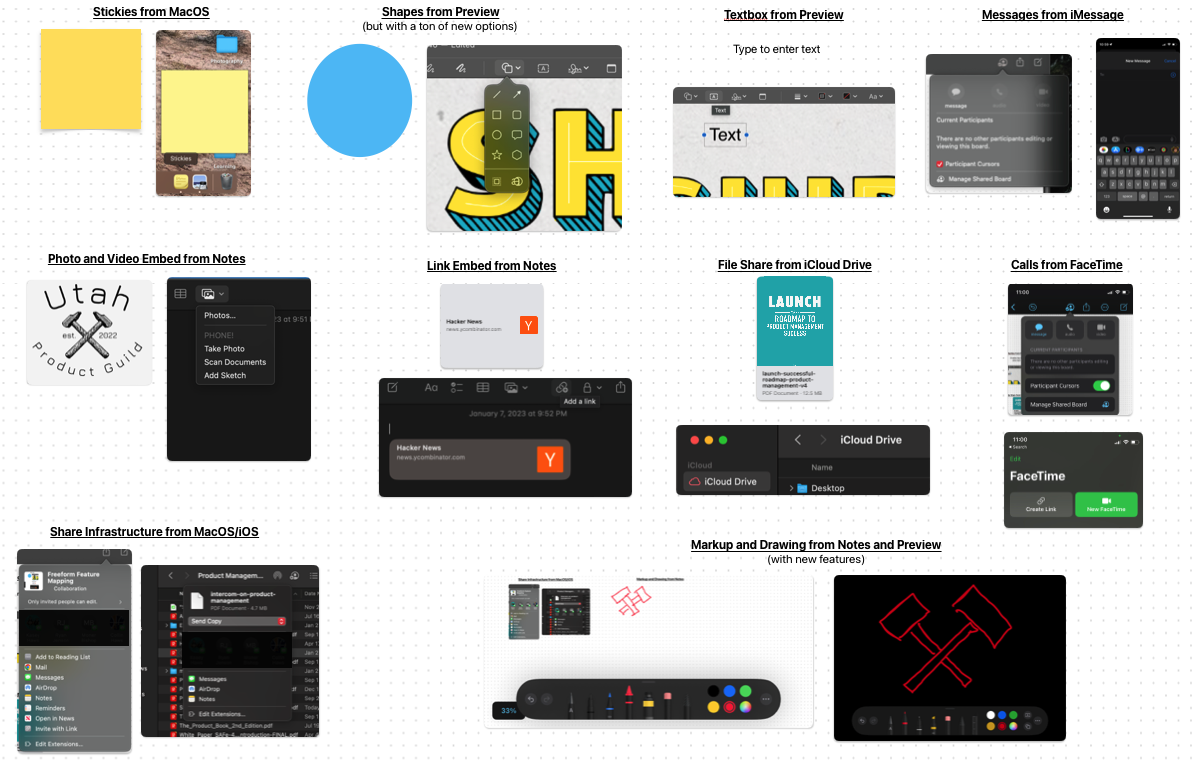In 2006 Creative Technologies sued Apple.The reason for the suit? Apple allegedly stole ideas and designs that led to the iPod. The case was eventually settled for $100 million. In another act of borrowing, Apple added a mouse to their computers after Steve Jobs saw one at Xerox PARC. To be fair Apple did change the mouse up, theirs had two fewer buttons than the Xerox version and cost $275 less. Apple is often looked at as an innovator, but they do their fair share of borrowing from others. (Nothing wrong with this, all artists steal or build upon the ideas of their predecessors).
Apple recently released Freeform, an infinite whiteboard. It is their answer to tools like Figjam and Miro. These tools all have a similar feature set, focused on free-form thinking and collaboration. But how Apple arrived at that feature set feels a bit different, they stole from themselves.
Apple had a few advantages in getting started. It had several competitors who had done the work of customer discovery. Apple could look to them for the types of features customers wanted. There was an advantage in most of the required functionality existing in some of their other products. (This was not a free advantage, it had been earned through decades of development). And as my friend (and Utah Product Guild member), Isaac Corcoran pointed out, these existing features also let them do things their competitors could not, like embedding video.
In a bit of meta work, I used Freeform to map out its features to the Apple products where they originated. Outside of the whiteboard itself, Apple didn’t have to build much new stuff. They were able to pull in note-taking and drawing tools from other document-based products. They used their existing sharing infrastructure to enable sharing with Freeform. And they integrated messaging and video call platforms to allow for real-time collaboration. To their credit, they did add some enhancements like expanding the drawing tools.

Freeform is a fascinating case study of taking a set of disparate features and combining them to create something new and exciting. While I wouldn’t say Freeform is any better than its competitors, it is comparable and came at a much lower price. Since they were able to build off existing products their costs were much lower. This means they can offer Freeform at a cheaper price, in this case making it free.
As an Apple user, my hope is that they further dig into this reusing of features. I’ve long wanted to be able to embed a pdf into an Apple Note. Or embed a video into a Reminder. And in the world of Freeform, it would be great to be able to add Reminders to a Whiteboard. There is a whole world of enhancements made possible by combining existing features.
I’ve seen similar approaches taken at past companies. A demand tracker in one product is repurposed as a supply tracker in another. A tool for tracking details about professionals becomes a tool for tracking location details. When done correctly this reuse of features has several benefits. It allows your team to save time building from scratch. It is often more maintainable as your team already knows that part of the code base. And there can be a lot of goodwill built up with customers. They may not realize that you’ve reused a feature and will think you built something new for them. If they do recognize the approach, they will be happy to have their problem solved by a familiar form factor.
While it’s great that Apple has found success here, their ability to execute was never in doubt. The bigger question is what this means for us as product managers. A few things that we can take away from Apple’s work on Freeform:
- Identify the core features and functionality of your existing products. Look for opportunities to combine or repurpose these features in new, innovative ways.
- Think about scalability and modularity as you build new features. This will make it easier to reuse and recombine them down the road if needed.
- Research your competition, and see if they have products in the market that you should be competing with. Then examine if you can build it by combining your existing features. Let them do the heavy lifting of discovery and finding product market fit. Then you can come in with a superior or differentiated experience.
- Leverage your existing user base to drive adoption and awareness of the new product. In Apple’s case, they made Freeform the focus of major updates to all three of their operating systems.
It remains to be seen how well Freeform does for Apple. But they’ve put themselves in the conversation at a much lower cost than their competitors. There’s lots of upside for them and more importantly upside for their customers.
Reusing features and functionality isn’t always the right answer. But it's something to consider the next time you set out to build something new.
Where else have you seen this done well? Where have you seen it done poorly? Are there any other companies that you wish would do some mashups as Apple did with Freeform? I would love to hear your thoughts and examples.
